-
AGU Virtual globes session will be a live (free) webcast on 15 Dec 10:20am SF time
Category Archives: Uncategorized
links for 2009-12-06
-
Oblique projections coming to Google Maps API as well?
-
TechCrunch: As Google embraces HTML5, Microsoft pushes Silverlight
-
Qt graphics toolkit (used to build Google Earth) now supports Symbian. GE for Symbian soon?
-
Google explains its naming policy for disputed areas on maps – a long time coming, but no surprises
Microsoft’s new Bing Maps Beta: Whither Virtual Earth?
Microsoft’s new Bing Maps Beta was released this week, and as Chris Pendleton outlines on his blog, it integrates a range of existing data (satellite imagery, map data, panoramic imagery, PhotoSynth, bird’s eye imagery, photogrammetric data) into a much more seamless web mapping experience, leveraging to the hilt the 3D capabilities of Microsoft’s Silverlight 3 plugin.
Chris doesn’t mention one of the most laudable consequences of the switch to Silverlight — the new Bing Maps Beta works equally well with Macs and PCs. But this comes at an apparent cost that isn’t mentioned either — the old ActiveX-driven Virtual Earth disappears from the new Bing Maps as released this week.
This appears to be confirmed by the caution box now at the top of the article Getting Started with Bing Maps 3D:
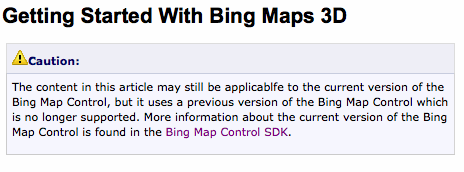
(You can still access the old Virtual Earth (on a PC) by exiting the Beta to the old Bing Maps — click the help button on the bottom right of the screen.)
The upshot: While the new Bing Maps now gives you oblique views from quite far out and for all four cardinal points, including of mountainous regions such as the Alps and the Karakorum, the Earth does not start curving as you zoom out. Microsoft’s new Bing Maps 3D is a flat Earth. That’s just as with the 2D Google Maps, of course, but now Microsoft no longer boasts a supported competitor in the virtual globe product space, à la Google Earth web plugin or standalone application.
I’m not lamenting the disappearance of Virtual Earth/Bing Maps 3D. With labels hard-coded into the tiles, rotating the view meant reading names upside down, while its Mac-incompatibility despite being a web app prevented it from becoming a universal resource for referencing a place or view. In the New Bing Maps labels are always right-side up, because either North is up, or because the oblique views of the cardinal points have been prerendered. And the New Bing Maps also takes over some of the features previously found in Virtual Earth, such as the “flying” from one location to another and smooth zooming (of a sort).
Chris Pendleton has hinted that there is much more to come to Bing Maps. Possibly, this means they are working on a virtual globe built with Silverlight, so this may just be an interlude in a long competitive race. Or else, Microsoft may have conceded the fight, reasoning that the bulk of the financially rewarding mapping happens at close zoom and in cities, where Bing Maps is indeed at its strongest. It may have decided that pre-rendered oblique views of much of the Earth at close range is “good enough”.
That would be bad for Google Earth, of course. We want Google Earth developers to live in fear of being bested:-) But at the same time, it cannot possibly be the case that Google Earth is a profit center for Google. Unimaginably valuable PR it is indeed, but not an advertising cash cow. And since Virtual Earth never got the same media kudos as Google Earth for its positive social and educational role, there may be less incentive at Microsoft to compete head to head in this arena.
Since I’m on the topic of Bing Maps, some further points regarding stuff I’ve run into this week as I played with the Beta:
Matterhorn Test: As usual, I checked out my favorite mountain, the Matterhorn, to see how it looks in the new oblique view. Unfortunately, I ran into a data problem. All along the Swiss-Italian border, Italian imagery takes precedence over Swiss imagery, so a thick white strip along Italy’s border sits atop the Matterhorn and the entire Swiss side of the border. Oops.
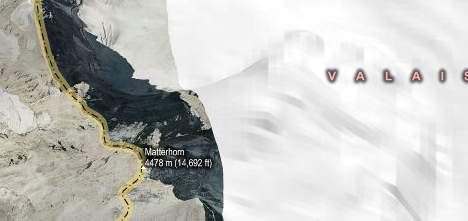
Global reach: This is an old bugbear of mine, but it is still relevant. Yes, Microsoft adds scores of terrabytes of new data to its maps every month, though most of it is of North America and Europe (and now China). I tend to use maps not for the places I know, but for the places I want to go (or can’t) — Africa, Arabia, Vietnam… I need street data for places like Sana’a and Saigon, where Google delivers but Microsoft not. I can understand Microsoft’s prioritization, and also that I may be an atypical user, but it also means I continue to use Google for my everyday mapping needs.
Case study: I hit upon a blog post about the Majlis al Jinn cave in Oman (with a cavern big enough to fit the Khufu Pyramid), and became intrigued enough to want to find out where it was, and if the sink holes were visible in aerial imagery. A search in Google Earth for “majlis al jinn” returned this:

And a DigitalGlobe image from 2006 that shows individual cars parked next to the entrance:
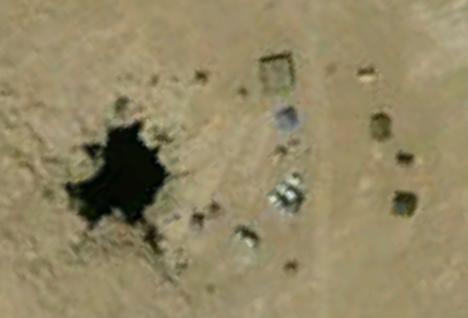
Google Maps functions in exactly the same way:
But Bing Maps can’t find it, and if I zoom in manually on the place, we get no reference points and 15m base imagery:

I know this is just one anecdotal example, but these are the kinds of comparative experiences I keep on having, and it is here that, for me, Bing Maps needs to improve before it can become a tool I use regularly. No matter how good the display technology, it is the quality, reach and searchability of the underlying content that ultimately adds the most value to my user experiences.
links for 2009-12-04
-
360Cities vs Google Street View in the Czech Republic: Quality vs scalability (both have their strengths)
links for 2009-12-02
-
New Audi A8 to get Google Earth-based navigation system (+3G+wifi)
Google Earth: Three trends for 2010
It’s not that I’ve stopped paying attention to the social implications of neogeography in general and Google Earth in particular: It’s simply been a quiet few months in the niche topic Ogle Earth covers. Maybe this is because the new geospatial technologies introduced these past few years are now being embraced by the mainstream, so there are fewer opportunities for disruptions to long-held assumptions, both among users and politicians. Just as with the plain-vanilla web before it, people are now getting the geoweb.
But this lull gives us the space to focus on three unheralded yet significant trends in Google’s mapping service, which are going to make it an even more useful product than it is now.
1. Imagery freshness:
With every monthly imagery update since August 2009, Google has made available a KML file outlining where all the new imagery is to be found (on Google Lat-Long Blog). This makes it very easy to check up on new imagery in areas of interest.
It used to be that newly added imagery would be at least 6 months old, but usually a year or more. Perhaps this was by agreement with Digital Globe or because of an internal process. Since a few months ago, however, a good chunk of the imagery has been just weeks old. It’s basically being added to the dataset as quickly as it is gathered.
The traditional complaint of Google Earth users has been that the imagery was outdated, often by several years. In fast-developing places like China, that kind of delay is especially frustrating. This new bias towards near-realtime updates is a huge improvement to the usefulness of the satellite imagery as a tool, but one that is not immediately obvious if you’re not paying close attention to the metadata.
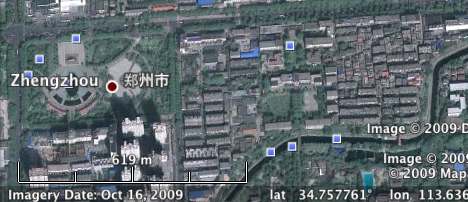
2. Map and imagery correlation:
European and American cartographical institutions have long synced their products with the geodetic system used by standard GPS devices, WGS84. As a result, map data and imagery across Europe and the US correlate well, often to within a few meters. On Google Maps, you can switch between the map and the imagery without confusion. Place a feature on one dataset and it is accurately positioned on the other.
Not so in other parts of the world. When I lived in Egypt during 2007-2009, the road layer and other map data for Egypt was positioned some 125 meters NW of the imagery, because it was prepared using some other geodetic system datum. Even imagery tiles were sometimes badly stitched together, with errors of up to 20 meters at the seams (as blogged here).
Now that I have moved to China and am looking closely at the local data around me, I’ve noticed the situation here is even worse. The map and imagery layers are off by 250 to 500 meters across all of China. This is causing all sorts of problems that will have repercussions in the future, even after these discrepancies have been reconciled, because a lot of user-generated data is being created on top of the map layer, and this content then bleeds into Google Earth and Google Maps’s imagery layer, where the locations are plain wrong. The opposite happens also, (though without repercussions for the future): Wikipedia placemarks that are accurate in Google Earth are misplaced in Google Maps’s maps layer:
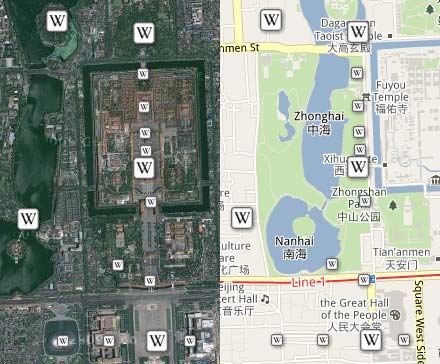
But Google is working to make things better. Egypt recently received a revamped map layer, and now the discrepancy is only 10-20 meters from the GPS reading. The content generated on top of the old map data is still in evidence, however, so for a while yet we will have to deal with inaccurate POIs, such as hotels situated in the middle of the Nile:

In fact, both Egypt and China are exceptions, because neither country is currently included in Google Mapmaker, a community effort focused on the developing world that lets users generate objects on the map layer aligned with the underlying satellite imagery. Vietnam, for example, enjoys a high degree of alignment between the two datasets; this is how mapping is now being done for most places in Google Earth outside Europe and the US, and the results are replacing existing substandard or incomplete datasets.
For extra credit: Hong Kong also has a good fit between the two datasets, which led me to wonder if there might be a visible edge between HK’s accurate map data and China’s off-kilter data. Sure enough, the two datasets clash quite dramatically, with lots of roads to nowhere:
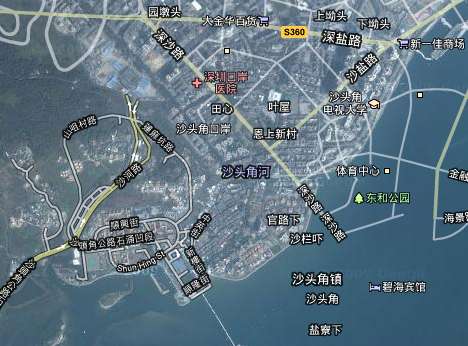
The Chinese version of Google Maps, ditu.google.cn, introduces an interesting hack to fix this discrepancy around Hong Kong. If you turn on hybrid mode and scroll across the border from Hong Kong to mainland China, the background imagery tiles will suddenly shift to the Chinese geodetic system, so as to correlate with the foreground map data. In the image below, the imagery tiles have shifted to accommodate the Chinese map datum.

3. Cloud-power:
For a while now, Google Maps’s My Maps has allowed Google account holders to create and share simple maps via a web browser, storing the content on Google’s servers. Google Earth, even though it has far more sophisticated tools for creating content, has never been connected to Google’s account management cloud. Yes, there is a sidebar in Google Earth containing all your user-generated and downloaded content, but it isn’t synced with Google, nor can you easily share it via Google’s servers. Instead, you have to manually upload it to your own server or to Google Earth Community, after which the public content is no longer synced with the version on your desktop (obviously).
It’s long been mooted that this stuff could and should be synced with the cloud, just as with Google Maps. For example, you might be able to choose which datasets you want to share; subscribers to your content would then see the changes live as you update it, just as your subscriptions to the content of others would be automatically updated.
We’re not there yet, but two weeks ago Google took a step in that direction by linking My Maps to Google Earth for the iPhone. As a result, all the maps I’ve made over the past few years with My Maps are suddenly available on my iPhone via Google Earth. For example, these georeferenced photos of a trip to Ethiopia:
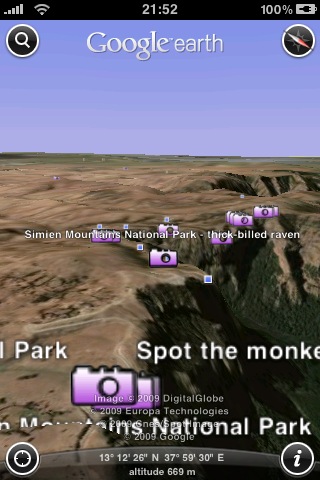
In effect, the Google Earth iPhone app now better connected to the cloud than the standalone Google Earth, but somehow I suspect that this is not how things will remain.
My Maps doesn’t currently support imagery overlays, so it doesn’t parse all the KML Google Earth’s content would throw at it, but there is no technical reason for it not to. It’s just a hunch, but I think that Google Earth’s next big revamp is going to involve a more intense integration of user data with the cloud. (Especially as such user data is something you can sell ads against :-)
PS:
A bit off-topic, but I can’t let this be: Sometime in the past few months, between the last time I checked and this week, Google Earth gained a high-resolution image of our planet’s remotest island, Norway’s Bouvetøya. The imagery is from 2008, even, and it is just gorgeous:
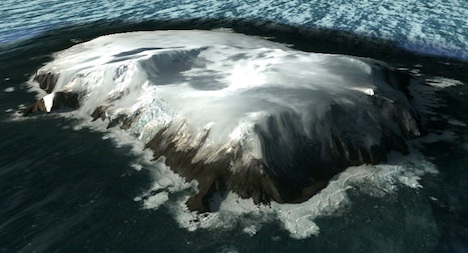
Considering it is one of the places I am least likely to end up at, I will settle for this high-resolution view.
links for 2009-11-04
-
Researchers: Volcanic rift in Ethiopia is beginning of a new sea. Will be fun to follow this on GE